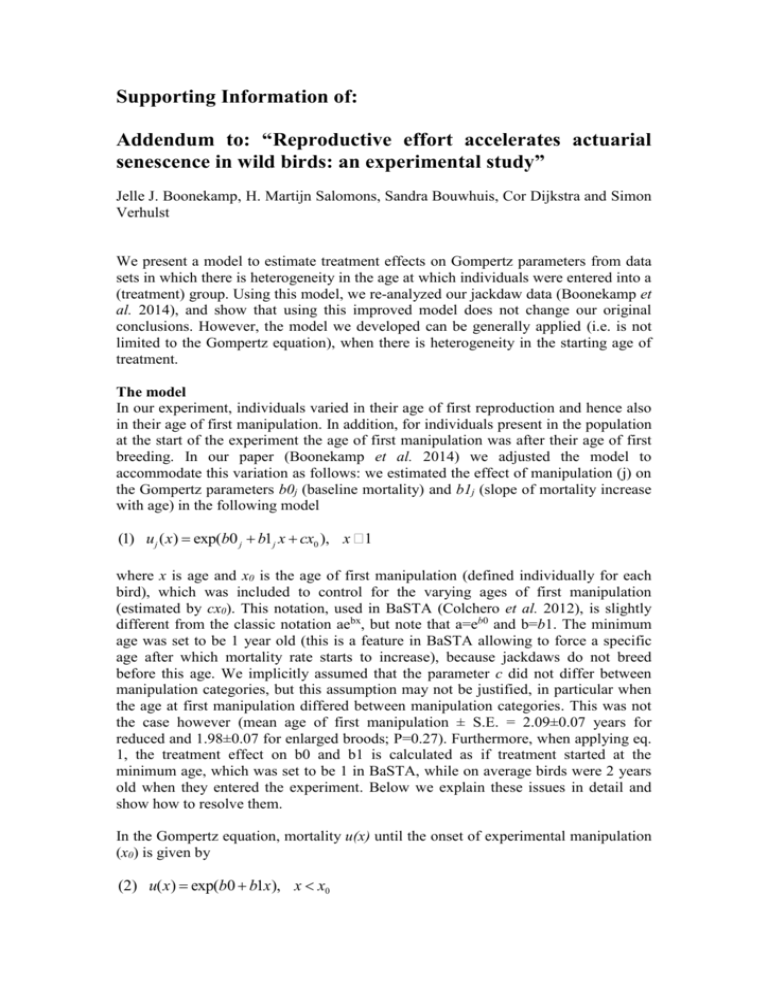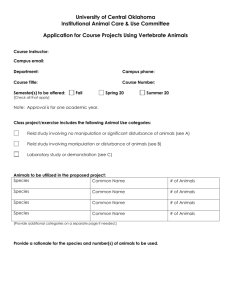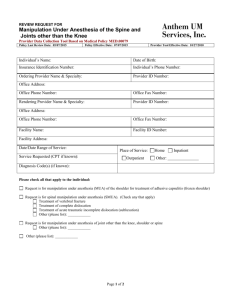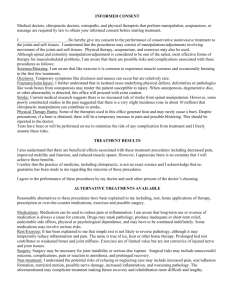ele12404-sup-0001-SuppInfo
advertisement

Supporting Information of: Addendum to: “Reproductive effort accelerates actuarial senescence in wild birds: an experimental study” Jelle J. Boonekamp, H. Martijn Salomons, Sandra Bouwhuis, Cor Dijkstra and Simon Verhulst We present a model to estimate treatment effects on Gompertz parameters from data sets in which there is heterogeneity in the age at which individuals were entered into a (treatment) group. Using this model, we re-analyzed our jackdaw data (Boonekamp et al. 2014), and show that using this improved model does not change our original conclusions. However, the model we developed can be generally applied (i.e. is not limited to the Gompertz equation), when there is heterogeneity in the starting age of treatment. The model In our experiment, individuals varied in their age of first reproduction and hence also in their age of first manipulation. In addition, for individuals present in the population at the start of the experiment the age of first manipulation was after their age of first breeding. In our paper (Boonekamp et al. 2014) we adjusted the model to accommodate this variation as follows: we estimated the effect of manipulation (j) on the Gompertz parameters b0j (baseline mortality) and b1j (slope of mortality increase with age) in the following model (1) u j (x) = exp(b0 j + b1j x + cx0 ), x ³ 1 where x is age and x0 is the age of first manipulation (defined individually for each bird), which was included to control for the varying ages of first manipulation (estimated by cx0). This notation, used in BaSTA (Colchero et al. 2012), is slightly different from the classic notation aebx, but note that a=eb0 and b=b1. The minimum age was set to be 1 year old (this is a feature in BaSTA allowing to force a specific age after which mortality rate starts to increase), because jackdaws do not breed before this age. We implicitly assumed that the parameter c did not differ between manipulation categories, but this assumption may not be justified, in particular when the age at first manipulation differed between manipulation categories. This was not the case however (mean age of first manipulation ± S.E. = 2.09±0.07 years for reduced and 1.98±0.07 for enlarged broods; P=0.27). Furthermore, when applying eq. 1, the treatment effect on b0 and b1 is calculated as if treatment started at the minimum age, which was set to be 1 in BaSTA, while on average birds were 2 years old when they entered the experiment. Below we explain these issues in detail and show how to resolve them. In the Gompertz equation, mortality u(x) until the onset of experimental manipulation (x0) is given by (2) u(x) = exp(b0 + b1x), x < x0 After the onset of the experimental manipulation j, mortality uj(x) is (3) u j (x) = exp(b0 + B0 j + b1x0 + (b1+ B1j )(x - x0 )), x ³ x0 where b0 and b1 represent pre-treatment mortality rate and B0j and B1j represent the effect of the treatment j on baseline and age specific mortality rate respectively from x0 onwards. Because observations did not start before the onset of treatment (i.e. most birds start breeding in the year that they entered the population), b0 and Bj0 and b1x and B1jx cannot be estimated separately. In eq.1 the mortality components b0 and b1 therefore estimate the pre- and post-onset-of-manipulation mortality components combined, i.e. b0eq.1 = b0+Bj0 and b1eq.1 = b1+B1j, for x ≥ x0. Because all observations were after the onset of treatment (x ≥ x0) eq. 3 can be simplified by (4) u(x) = exp(b 0 + b1x + b1x0 ), x ³ x0 where β0 = b0 + B0j and β1 = b1x + B1jx and b1x0 is equal to cx0 in model 1. The key difference between models 1 and 4 is that in model 4 the Gompertz parameters are estimated from the onset of manipulation (x ≥ x0) instead of ages x ≥ 1, and hence the estimates are no longer confounded with pre-treatment mortality. To implement eq. 4 in BaSTA, we defined the year of first manipulation as year of birth (i.e. year of birth = x0) and included the age of first manipulation (x0) as proportional hazard term similar to cx0 in eq. 1. This specific setup allows BaSTA to estimate β0 and β1 from the moment of treatment onwards (x ≥ x0) as in eq. 4. Simultaneously the model adjusts the mortality level with respect to the age of first manipulation (cx0). Results When fitted to our data, the posterior distributions of β0 and β1 estimated with the model of eq. 4 are indistinguishable from our previous estimates (Fig. S-AD 1, table S-AD 1). The estimated effect of the age of first manipulation in the model did not significantly differ from 0 (mean cx0 = 0.094, C.I. = -0.15, 0.34), indicating negligible mortality before the onset of manipulation. This is expected in our specific case, because all observations were after the onset of treatment (x ≥ x0) and hence pretreatment mortality was not observed. In our paper we repeated the analysis of the manipulation effects for a subset of the data: the resident birds (residency was defined as birds breeding at least 2 consecutive years in the same colony). We added this analysis because in residents mortality is less confounded by emigration. The estimates of β0 and β1 for residents using the model of eq. 4 were also indistinguishable from our previous estimates (Fig. S-AD 1, table S-AD 1). Conclusions Our original model formulation yielded biased estimates of the Gompertz parameters, because it did not properly account for variation in the age at which birds entered the experiment. Equation 4 that we present here can be used to estimate the effect of experimental treatment on age-specific mortality, even when there is variation in the age at which treatment commenced. The model can be implemented in BaSTA by defining the year of first manipulation as year of birth and including the age at first manipulation as covariate. In our specific case, this model produced results that were indistinguishable from our original results. However, we attribute this to specific aspects of our data set, and generally recommend to fit equation 4 when one aims to quantify differences between groups in mortality parameters while there is variation within groups in the age at which individuals are entered in the group. References 1.Boonekamp, J.J., Salomons, M., Bouwhuis, S., Dijkstra, C. & Verhulst, S. (2014). Reproductive effort accelerates actuarial senescence in wild birds: an experimental study. Ecology Letters, 17, 599–605. 2.Colchero, F., Jones, O.R. & Rebke, M. (2012). BaSTA: an R package for Bayesian estimation of age-specific survival from incomplete mark-recapture/recovery data with covariates. Methods in Ecology and Evolution, 3, 466–470. Table S-AD 1: statistical estimation of β0 and β1 based on eq. 4 (denoted ‘new’) and b0 and b1 based on eq. 1 (denoted ‘old’) and their 95% confidence intervals. Manipulation Total Reduced Enlarged Residents Reduced Enlarged new (eq.4) β0 old (eq.1) b0 new (eq.4) β1 old (eq.1) b1 -1.62(-2.41, -0.94) -1.86(-2.58, -1.17) -1.25(-1.88, -0.60) -1.59(-2.34, -0.87) 0.09(-0.06, 0.31) 0.42(0.14, 0.75) 0.15(-0.04, 0.37) 0.50(0.19, 0.83) -3.41(-4.50, -2.34) -3.74(-4.90, -2.65) -2.96(-4.21, -1.85) -3.35(-4.60, -2.23) 0.45(0.10, 0.80) 0.90(0.50, 1.30) 0.60(0.25, 0.99) 1.08(0.65, 1.56) Fig. S-AD 1 Age-specific survival and mortality rates estimated by eq.4 using (a) the total number of individuals and (b) the subset of resident birds, rearing reduced or enlarged broods. The colored areas in the survival graphs represent the 95% confidence intervals. Posterior distributions of b0 and b1 are shown, where b0 determines the intercept and b1 the slope of the natural logarithm (ln) of age dependent mortality rate [u(x)], which is plotted on the right side. Posterior distributions with a divergence of > 95% are highlighted with an asterisk (*).








